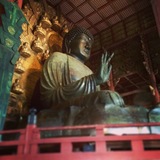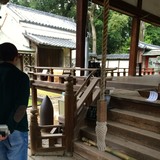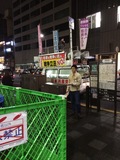 Sonic Tourism at Himuro Shrine
Sonic Tourism at Himuro ShrineStevens and Hosokawa visited the Himuro Shrine in Nara, an ancient city about an hour outside Kyoto. This shrine was established in 710. At this shrine, there was a small playback device at the place of offering. Supplicants put coins in the box at the shrine entrance to make wishes for good health, fortune or other prayers. Next to the donation box was a small recording playback device, donated by an audio speaker company (credited with a small sign). If the supplicant put a few more coins in the device, they could hear gagaku (ancient court music) playing through these speakers. The ancient sounds were thought to enhance the experience of praying at this historic shrine. You can hear Prof. Hosokawa drop in the coins at the start of the recording, and then while waiting, muse out loud 'Nothing's coming out!' As soon as he utters this sentence, however, the recording begins. The supplicant is taken back to Nara's ancient period with this sound. Through the playback you can hear other tourists come and go, and put money in the donation box as the music plays. Hosokawa and Stevens found this shrine's feature unusual and interesting, dubbing it 'sonic tourism'. Sonic tourism enhances the physical experience of being present in a historic setting. (2015/04/06)

 Exercises at Kindergarten
Exercises at Kindergarten
 Ameyoko
Ameyoko
 University Coffee Shop
University Coffee Shop
 Shopping strip at Ginkaku-ji
Shopping strip at Ginkaku-ji

 The Basement of Isetan, 2015
The Basement of Isetan, 2015
 At the Top of the Kyoto Tower
At the Top of the Kyoto Tower
 Music at the Top of Kyoto Tower
Music at the Top of Kyoto Tower
 The Sound of Udon
The Sound of Udon
 The Sound of Retail
The Sound of Retail
 Yasaka Shrine
Yasaka Shrine
 Toad's Oil - traditional storytelling
Toad's Oil - traditional storytelling
 Arriving in Kyoto in style
Arriving in Kyoto in style
 Special Express Train to Kyoto from Nara
Special Express Train to Kyoto from Nara
 Multicultural Todaiji
Multicultural Todaiji
 Sonic Tourism at Himuro Shrine
Sonic Tourism at Himuro Shrine
 Rubbish Collection in Kyoto
Rubbish Collection in Kyoto
 Japanese Communist Party Sound Truck at Shijo
Japanese Communist Party Sound Truck at Shijo 
 Okonomiyaki in Teramachi, Kyoto
Okonomiyaki in Teramachi, Kyoto
 Dancers in the Teramachi Shopping Arcade
Dancers in the Teramachi Shopping Arcade
 Viewing Cherry Blossoms from the Uji River at the Sakura Matsuri (Cherry Blossom Festival
Viewing Cherry Blossoms from the Uji River at the Sakura Matsuri (Cherry Blossom Festival 
 Chasoba in Uji
Chasoba in Uji
 Sakura Matsuri (Cherry Blossom Festival) in Uji
Sakura Matsuri (Cherry Blossom Festival) in Uji
 Election Trucks in Kyoto
Election Trucks in Kyoto
 Kindergarten kids on school trip in Kyoto
Kindergarten kids on school trip in Kyoto
 Candidate Sound Trucks in Kyoto
Candidate Sound Trucks in Kyoto
 Miso Ramen at the Kyoto Ramen Kōji (Lane)
Miso Ramen at the Kyoto Ramen Kōji (Lane)
 Kyoto Ramen Kōji (Lane)
Kyoto Ramen Kōji (Lane)
 Haruka Express from Kansai Airport to Kyoto
Haruka Express from Kansai Airport to Kyoto